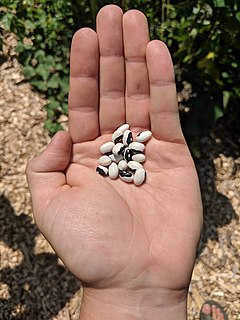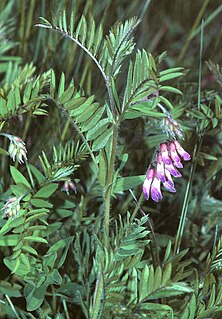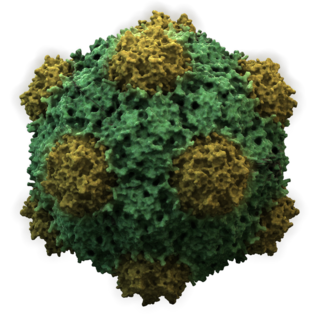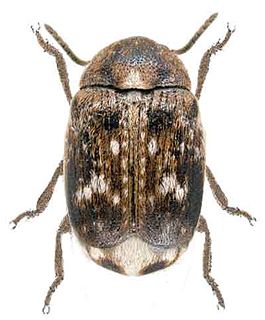
A bean is the seed of one of several genera of the flowering plant family Fabaceae, which are used as vegetables for human or animal food. They can be cooked in many different ways, including boiling, frying, and baking, and are used in many traditional dishes throughout the world.

Vicia faba, also known in the culinary sense as the broad bean, fava bean, or faba bean, is a species of flowering plant in the pea and bean family Fabaceae. It is of uncertain origin and widely cultivated as a crop for human consumption. It is also used as a cover crop. Varieties with smaller, harder seeds that are fed to horses or other animals are called field bean, tic bean or tick bean. Horse bean, Vicia faba var. equinaPers., is a variety recognized as an accepted name.

A legume is a plant in the family Fabaceae, or the fruit or seed of such a plant. When used as a dry grain, the seed is also called a pulse. Legumes are grown agriculturally, primarily for human consumption, for livestock forage and silage, and as soil-enhancing green manure. Well-known legumes include alfalfa, clover, beans, peas, chickpeas, lentils, lupins, mesquite, carob, soybeans, peanuts, and tamarind. Legumes produce a botanically unique type of fruit – a simple dry fruit that develops from a simple carpel and usually dehisces on two sides.

Vicia is a genus of about 140 species of flowering plants that are part of the legume family (Fabaceae), and which are commonly known as vetches. Member species are native to Europe, North America, South America, Asia and Africa. Some other genera of their subfamily Faboideae also have names containing "vetch", for example the vetchlings (Lathyrus) or the milk-vetches (Astragalus). The broad bean is sometimes separated in a monotypic genus Faba; although not often used today, it is of historical importance in plant taxonomy as the namesake of the order Fabales, the Fabaceae and the Faboideae. The tribe Vicieae in which the vetches are placed is named after the genus' current name. Among the closest living relatives of vetches are the lentils (Lens) and the true peas (Pisum).

Lettuce mosaic virus (LMV) is a typical potyvirus, which causes one of the major virus diseases of lettuce crops worldwide.

Lupinus albus, commonly known as the white lupin or field lupine, is a member of the genus Lupinus in the family Fabaceae. It is a traditional pulse cultivated in the Mediterranean region.

Alfalfa mosaic virus (AMV), also known as Lucerne mosaic virus or Potato calico virus, is a worldwide distributed phytopathogen that can lead to necrosis and yellow mosaics on a large variety of plant species, including commercially important crops. It is the only Alfamovirus of the Bromoviridae family. In 1931 Weimer J.L. was the first to report AMV in alfalfa. Transmission of the virus occurs mainly by some aphids, by seeds or by pollen to the seed.
Bean yellow mosaic virus is a plant pathogenic virus in the genus Potyvirus and the virus family Potyviridae. Like other members of the Potyvirus genus, it is a monopartite strand of positive-sense, single-stranded RNA surrounded by a capsid made for a single viral encoded protein. The virus is a filamentous particle that measures about 750 nm in length. This virus is transmitted by species of aphids and by mechanical inoculation.
Bidens mottle virus (BiMoV) is a pathogenic plant virus in the plant virus family Potyviridae. BiMoV is a flexuous filamentous particle, 720 nm long, and belongs to the Potyviridae genus Potyvirus. Like other viruses in this genus, Bidens mottle virus is transmitted both mechanically by sap and by aphids in a stylet-borne fashion.
Clover yellow mosaic virus (ClYMV) is a plant pathogenic virus in the genus Potexvirus and the virus family Alphaflexiviridae. Its flexous rod-shaped particles measure about 539 nm in length.

Cucumber mosaic virus (CMV) is a plant pathogenic virus in the family Bromoviridae. It is the type member of the plant virus genus, Cucumovirus. This virus has a worldwide distribution and a very wide host range. In fact it has the reputation of having the widest host range of any known plant virus. It can be transmitted from plant to plant both mechanically by sap and by aphids in a stylet-borne fashion. It can also be transmitted in seeds and by the parasitic weeds, Cuscuta sp. (dodder).
White clover mosaic virus (WClMV) is a plant pathogenic virus in the genus Potexvirus and the family Alphaflexiviridae. WClMV is a filamentous, flexuous rod, 480 nm in length and 13 nm wide.

Tobacco streak virus (TSV) is a plant pathogenic virus of the family Bromoviridae, in the genus Ilavirus. It has a wide host range, with at least 200 susceptible species. TSV is generally more problematic in the tropics or warmer climates. TSV does not generally lead to epidemics, with the exception of sunflowers in India and Australia, and peanuts in India.

Lawrence Ogilvie was a Scottish plant pathologist.

Secoviridae is a family of viruses in the order Picornavirales. Plants serve as natural hosts. There are currently 86 species in this family, divided among 8 genera or not assigned to a genus. The family was created in 2009 with the grouping of families Sequiviridae, now dissolved, and Comoviridae, now subfamily Comovirinae, along with the then unassigned genera Cheravirus, Sadwavirus, and Torradovirus.

The black bean aphid is a small black insect in the genus Aphis, with a broad, soft body, a member of the order Hemiptera. Other common names include blackfly, bean aphid, and beet leaf aphid. In the warmer months of the year, it is found in large numbers on the undersides of leaves and on the growing tips of host plants, including various agricultural crops and many wild and ornamental plants. Both winged and wingless forms exist, and at this time of year, they are all females. They suck sap from stems and leaves and cause distortion of the shoots, stunted plants, reduced yield, and spoiled crops. This aphid also acts as a vector for viruses that cause plant disease, and the honeydew it secretes may encourage the growth of sooty mould. It breeds profusely by live birth, but its numbers are kept in check, especially in the later part of the summer, by various predatory and parasitic insects. Ants feed on the honeydew it produces, and take active steps to remove the aphid's enemies. It is a widely distributed pest of agricultural crops and can be controlled by chemical or biological means. In the autumn, winged forms move to different host plants, where both males and females are produced. These mate and the females lay eggs which overwinter.

Organic beans are produced and processed without the use of synthetic fertilizers and pesticides. In 2008, over 2,600,000 acres (11,000 km2) of cropland were certified organic in the United States. Dry beans, snap beans, and soybeans were grown on 16,000 acres (65 km2), 5,200 acres (21 km2), and 98,000 acres (400 km2), respectively.

Bruchus is a genus of beetles in the leaf beetle family, Chrysomelidae. They are distributed mainly in the Palearctic, especially in Europe. Several occur in other parts of the world, such as North America, Africa, and Australia, as introduced species. Several species are notorious agricultural pests.
Fabavirus is a genus of plant viruses in the order Picornavirales, in the family Secoviridae, in the subfamily Comovirinae. Plants serve as natural hosts. There are currently seven species in this genus including the type species Broad bean wilt virus 1.

Nicola Spence is the Chief Plant Health Officer and Deputy Director for plant and bee health at the Department for Environment, Food and Rural Affairs.














